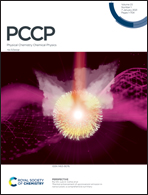The shape selectivity of corannulene dimers based on concave–convex and convex–convex shape complementarity as hosts for C60 and C70†
Abstract
In the formation of noncovalent complexes, the stacking arrangements of corannulene and fullerene are diverse, most of which are combinations of multiple corannulenes and fullerene. Here, a composition ratio of 2 : 1 was selected for the complex between corannulene and fullerene (C60 and C70) to investigate the effects of different superposition modes, including concave–convex and convex–convex interactions, on the stability and third-order nonlinear optical (NLO) properties of the composite materials. It was found that the concave–convex interaction was stronger and it was reported to stabilize the charge-transfer (CT) complex more effectively than the convex–convex interaction. The dispersion range of the concave–convex interaction was larger than that of the convex–convex interaction, which is consistent with the interaction energy results. The packing design with the double convex–convex interactions exhibited the largest linear optical response and third-order NLO response, which showed that the convex–convex interaction was more likely to be excited and cause intermolecular CT as compared to the concave–convex interaction. This work confirmed that the packing arrangement significantly affected the NLO response and will advance the development of NLO crystals.



 Please wait while we load your content...
Please wait while we load your content...